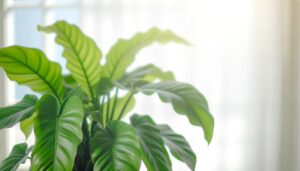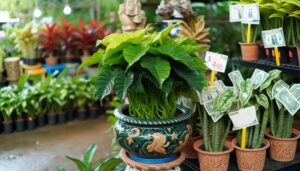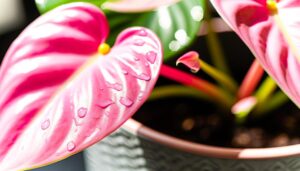What Is a Philodendron Birkin White Wave?
Philodendron Birkin White Wave, belonging to the Araceae family, is distinguished by its variegated leaves adorned with striking white pinstripes, resulting from selective breeding and genetic manipulation. The plant typically grows to a height of 1 to 2 feet and requires bright, indirect light to maintain its chimeric variegation.
It thrives in well-draining soil with a pH of 5.5 to 7.0 and requires a consistent humidity range of 60-80%. Regular pruning, bi-weekly fertilization with a balanced N-P-K ratio, and vigilant pest management are essential for ideal growth.
To uncover additional insights, continue exploring the detailed aspects of its care and maintenance.

Key Takeaways
- Philodendron Birkin White Wave is a hybrid plant known for its variegated foliage with distinctive white pinstripes.
- It has a moderate growth rate, typically reaching 1 to 2 feet in height with an upright growth habit.
- The plant thrives in well-draining soil, with humidity levels between 60-80% and temperatures of 18-27°C.
- Proper care includes bright, indirect light, regular pruning, and bi-weekly fertilization during active growth.
- Ideal for indoor environments, it requires consistent humidity and temperature regulation to maintain its unique leaf variegation.
Origins

The Philodendron Birkin White Wave, a variety of the Philodendron genus, was developed through selective breeding to highlight its distinct variegated foliage. This variety belongs to the Araceae family, renowned for their decorative value and ease of upkeep.
The Philodendron Birkin White Wave is a result of hybridization efforts aimed at enhancing the visual appeal of indoor plants. Genetic manipulation has resulted in its unique leaf patterns, distinguishing it from other Philodendron species. Cultivators prioritize maintaining ideal humidity levels (60-70%) and well-draining soil mixtures containing peat and perlite to promote robust growth.
Additionally, this variety thrives in indirect, bright light, avoiding both excessive sunlight and deep shade, ensuring its variegation remains vivid. Regular watering without waterlogging is crucial for healthy development.
Appearance
The Philodendron Birkin 'White Wave' is distinguished by its striking variegated foliage, featuring dark green leaves adorned with intricate white pinstripes.
Typically reaching a height of 1 to 2 feet, this cultivar exhibits a moderate growth rate under ideal conditions.
Understanding the specifics of its leaf coloration and growth dynamics is crucial for successful cultivation and maintenance.
Leaf Color and Patterns
Characterized by its striking variegation, the Philodendron Birkin White Wave exhibits leaves adorned with intricate white pinstripes against a lush green backdrop. This variegation pattern, known as chimeric variegation, results from genetic mutations that produce alternating sectors of pigmented and non-pigmented tissues.
The intensity and definition of the white pinstripes can vary, leading to a dynamic and ever-changing appearance. Younger leaves typically emerge with more pronounced variegation, which may evolve as the leaf matures.
Best variegation is maintained under bright, indirect light, as insufficient lighting can cause the white patterns to diminish. Additionally, the leaves' glossy texture reflects light, enhancing their visual appeal.
Regular pruning and careful monitoring of light conditions are essential to preserve the plant's distinctive aesthetics.
Size and Growth Rate
Philodendron Birkin White Wave typically reaches a mature height of 1 to 2 feet, with a relatively slow growth rate compared to other Philodendron species. This cultivar, known scientifically as Philodendron hederaceum 'Birkin', exhibits compact growth, making it suitable for limited indoor spaces. Its vertical growth is complemented by a moderate spread, generally spanning 1 to 1.5 feet.
| Attribute | Measurement | Notes |
|---|---|---|
| Mature Height | 1 to 2 feet | Compact and manageable indoors |
| Growth Rate | Slow | Requires patience for full maturity |
| Spread | 1 to 1.5 feet | Balanced with height |
Proper care, including consistent watering and indirect light, will optimize growth, although rapid expansion should not be expected.
Growth Habit
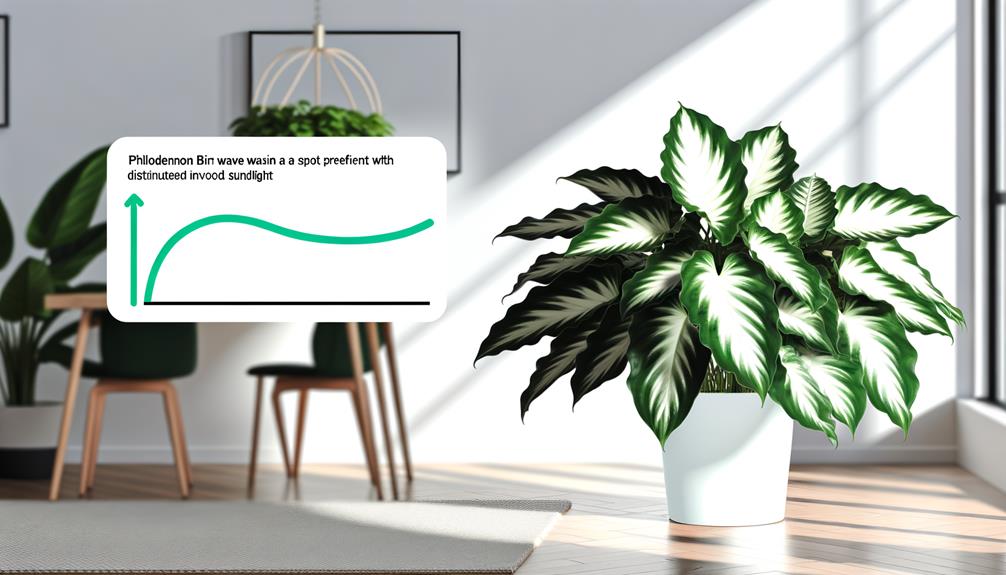
Philodendron Birkin 'White Wave' exhibits an upright growth pattern, typically reaching heights of 50-100 cm under best conditions.
The foliage presents significant leaf size variation, with individual leaves measuring between 10-20 cm in length, depending on environmental factors.
Proper light levels, ideally bright indirect light, are important for maintaining the plant's variegation and overall vigor.
Upright Growth Pattern
Displaying an upright and compact growth habit, the Philodendron Birkin 'White Wave' showcases a vertical growth pattern that sets it apart from other trailing or climbing Philodendron species. This specific growth habit is characterized by its self-supporting structure, minimizing the need for stakes or external support.
The node internodes are relatively short, contributing to its dense and bushy appearance. This growth pattern makes Philodendron Birkin 'White Wave' particularly well-suited for indoor environments with limited space. Best growth conditions include indirect, bright light and a well-draining potting mix.
Regularly rotating the plant ensures even light distribution, promoting symmetrical development. Additionally, maintaining moderate humidity levels and consistent, but not excessive, watering is essential for sustaining its robust and upright form.
Leaf Size Variation
In addition to its erect growth pattern, the Philodendron Birkin 'White Wave' exhibits significant variation in leaf size, which can be influenced by factors such as age, light exposure, and overall plant health. Younger plants generally produce smaller leaves, while mature specimens can develop larger foliage, ranging from 15 to 23 cm in length.
Best growth conditions, including consistent moisture levels and well-draining soil, also play an essential role. The variegation pattern, characterized by striking white striations, may become more pronounced as the plant ages.
Regular fertilization with a balanced, water-soluble fertilizer (e.g., 20-20-20) every four to six weeks during the growing season can further enhance leaf development and size. Proper care ensures strong and aesthetically pleasing foliage.
Light Requirements
Best light conditions are essential for the growth and variegation of the Philodendron Birkin 'White Wave', which thrives best under bright, indirect light. Inadequate light can diminish the plant's characteristic variegation, causing the leaves to revert to a more uniform green. For the best growth, place the Philodendron Birkin near an east or north-facing window, ensuring it receives filtered sunlight. Direct sunlight, particularly in the afternoon, can scorch the leaves, leading to discoloration and damage.
| Light Condition | Effect on Growth | Leaf Variegation |
|---|---|---|
| Bright, indirect | Optimal growth | Prominent variegation |
| Low light | Reduced growth | Faded variegation |
| Direct sunlight | Leaf scorch | Damaged variegation |
| Filtered sunlight | Healthy growth | Stable variegation |
| Artificial light | Moderate growth | Consistent variegation |
Maintaining proper lighting conditions is essential for sustaining the aesthetic appeal and health of Philodendron Birkin 'White Wave'.
Light Requirements
Ideal growth of Philodendron Birkin White Wave requires exposure to bright, indirect light to maintain its variegated foliage and overall health.
This light necessity is essential because direct sunlight can cause leaf scorch, leading to browning or yellowing of the leaves.
Philodendron Birkin White Wave (Philodendron hederaceum 'Birkin') thrives in light conditions that mimic the understory of tropical rainforests, where it receives dappled sunlight.
Artificial lighting, such as fluorescent or LED grow lights, can supplement natural light, especially in lower-light environments.
It is vital to rotate the plant periodically to guarantee even light distribution, preventing asymmetrical growth.
Insufficient light can lead to etiolation, where the plant becomes leggy and loses its characteristic variegation, compromising its ornamental appeal.
Watering Needs
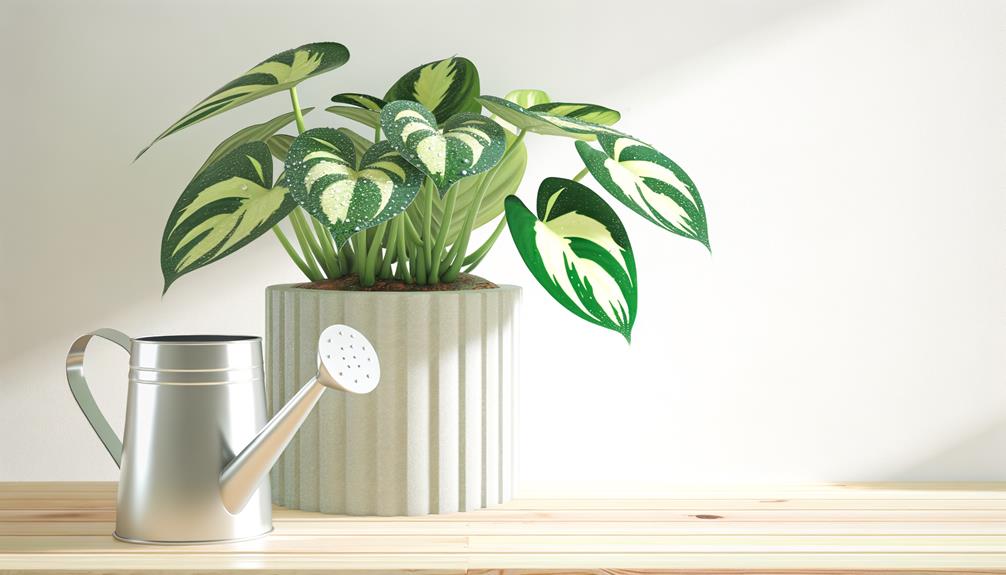
Proper watering practices are fundamental to maintaining the health and variegation of Philodendron Birkin White Wave, ensuring the soil remains consistently moist but not waterlogged. Overwatering can lead to root rot (Pythium spp.) and fungal infections, compromising the plant's energy.
Aim to water when the top inch of soil feels dry to the touch. Utilize filtered or dechlorinated water at room temperature to avoid potential chemical damage to the roots. Employ a well-draining pot to facilitate ideal water flow, preventing stagnation.
Monitoring ambient humidity levels, ideally between 60-70%, further supports the plant's hydration needs. Employing a hygrometer can assist in maintaining these conditions. Adjust watering frequency seasonally, reducing it during dormancy periods in winter.
Soil Preferences
For ideal growth, Philodendron Birkin White Wave needs a well-aerated soil mix rich in organic matter, guaranteeing sufficient drainage and nutrient availability. A blend of peat moss, perlite, and orchid bark is recommended, offering the necessary balance of moisture retention and aeration.
The organic matter, such as compost or leaf mold, provides essential nutrients and supports microbial activity, which improves plant health. It is pivotal to avoid compacted or heavy soils that can result in waterlogging, root rot, and suboptimal growth.
The soil pH should ideally range between 5.5 and 7.0, maintaining a slightly acidic to neutral environment. Regular monitoring and adjustment of the soil conditions are essential to ensure the long-term health of Philodendron Birkin White Wave.
Temperature and Humidity
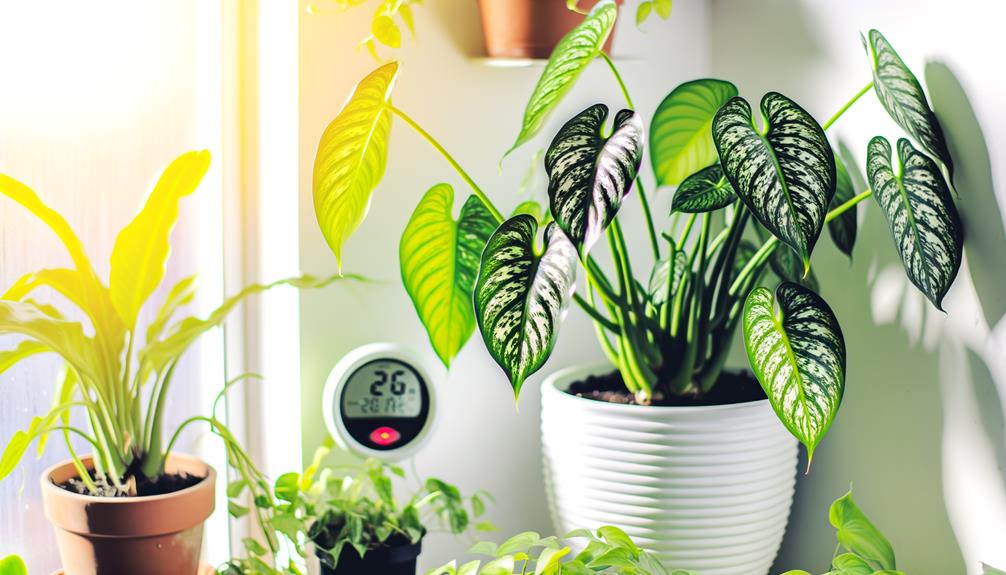
Philodendron Birkin thrives best within a temperature range of 18-27°C, where it can maintain robust growth.
This species also necessitates a relative humidity of 60-80% to prevent desiccation of its foliage.
Consistent regulation of these environmental parameters is essential for sustaining the plant's distinctive variegation and overall health.
Ideal Temperature Range
The best temperature range for Philodendron Birkin White Wave is between 65°F and 75°F (18°C to 24°C), with relative humidity levels maintained between 60% and 80%. This temperature range mimics the plant's natural tropical environment, ensuring prime growth and vibrant foliage.
Temperature fluctuations beyond this range can stress the plant, potentially leading to stunted growth or foliar damage. It is essential to avoid sudden temperature changes and cold drafts, as Philodendron Birkin White Wave is sensitive to such conditions.
Maintaining a stable and controlled environment can greatly enhance the plant's health and longevity. Proper monitoring with a reliable thermometer can help in maintaining the ideal temperature range, thereby promoting robust growth and aesthetic appeal.
Humidity Requirements
To thrive at its peak, Philodendron Birkin White Wave requires consistent humidity levels between 60% and 80%, mirroring its native tropical habitat. This high relative humidity supports ideal physiological processes such as transpiration and nutrient uptake. Low humidity can lead to desiccation of the foliage, manifesting in brown leaf tips and edges.
Employing a hygrometer to monitor ambient humidity is advisable. In environments where natural humidity is insufficient, utilizing a humidifier or placing the plant on a pebble tray with water can effectively elevate moisture levels. Additionally, misting the leaves periodically can offer temporary relief.
Ensuring adequate air circulation while maintaining high humidity helps prevent fungal infections, thereby fostering a robust and healthy Philodendron Birkin White Wave.
Fertilization
Effective fertilization of Philodendron Birkin White Wave requires the application of a balanced, water-soluble fertilizer with an N-P-K ratio of 20-20-20 during its active growing season. This typically spans from spring through early autumn.
Administer the fertilizer bi-weekly, ensuring it is diluted to half the recommended strength to prevent root burn (phytotoxicity). It is essential to monitor the plant for signs of nutrient deficiency, such as chlorosis or stunted growth, and adjust the fertilization regimen accordingly.
Organic alternatives, such as compost tea or fish emulsion, can supplement the primary fertilization method. Avoid fertilizing during the plant's dormancy in winter, as this can lead to nutrient build-up and potential root damage, compromising the plant's health.
Pruning and Maintenance
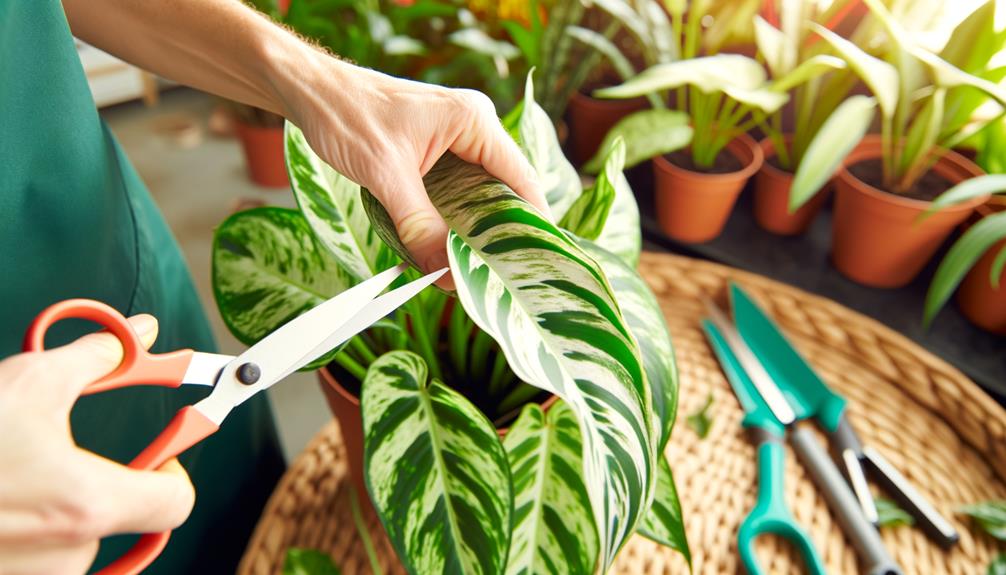
Pruning Philodendron Birkin White Wave involves the strategic elimination of yellowing or damaged leaves to promote ideal growth and sustain overall plant health. This process guarantees that the plant's energy is directed towards the development of new, vigorous foliage. Regular maintenance includes monitoring for signs of stress and promptly addressing any issues. Use sterilized pruning shears to cut near the base of the stem, but avoid excessive pruning as it can stress the plant.
Here is a quick reference guide for pruning:
| Task | Frequency |
|---|---|
| Inspect for damage | Weekly |
| Prune dead leaves | Monthly |
| Clean shears | Before each use |
| Remove yellow leaves | As needed |
| Check for pests | Weekly |
This routine secures the Philodendron Birkin White Wave remains vibrant and healthy.
Common Pests and Diseases
While regular pruning and maintenance are essential to the health of your Philodendron Birkin White Wave, vigilance against common pests and diseases is equally vital to guarantee its continued health.
The most prevalent pests include spider mites (Tetranychidae), aphids (Aphidoidea), and mealybugs (Pseudococcidae). These pests can cause chlorosis, stunted growth, and leaf deformities. To mitigate infestations, employ insecticidal soap or neem oil (Azadirachta indica) as a preventive treatment.
Additionally, fungal infections like root rot (caused by Phytophthora spp.) and leaf spot (caused by Xanthomonas campestris) pose significant threats. Ensuring proper drainage and avoiding overwatering are imperative to prevent these diseases.
Regularly inspect your plant for early signs of pest activity or disease to enable timely intervention.
Propagation Methods
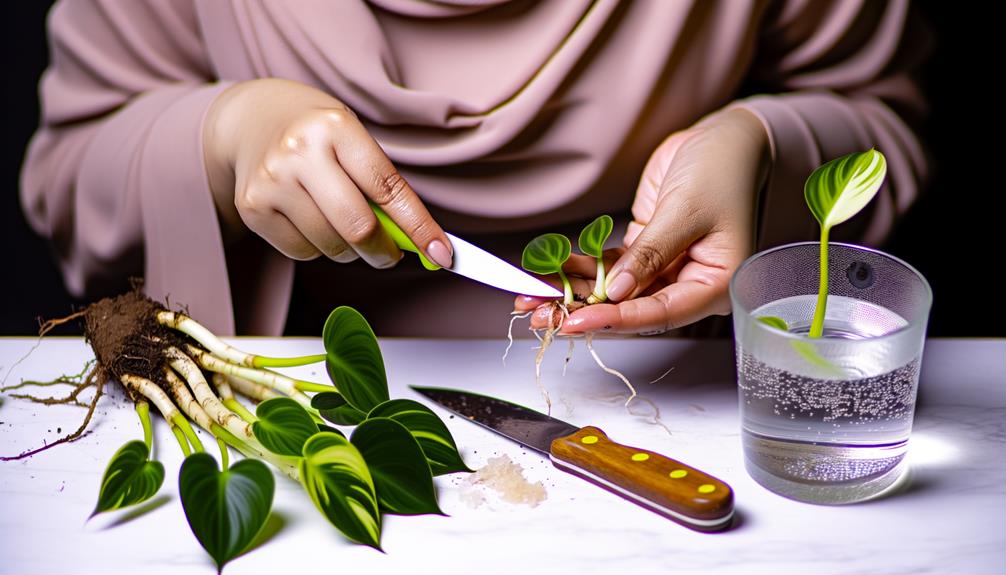
Propagation of Philodendron Birkin White Wave can be effectively achieved through stem cuttings, leveraging the plant's natural ability to root in moist, well-draining substrates. For best results, follow these steps:
- Select a Healthy Stem: Choose a stem with at least 2-3 nodes and no visible signs of disease.
- Clean Cutting Tools: Sterilize shears to prevent bacterial or fungal infections.
- Rooting Medium: Use sphagnum moss or a perlite-peat mix to maintain moisture balance.
- Humidity and Light: Place cuttings in a high-humidity environment with indirect light to promote root development.
Maintaining appropriate humidity and temperature conditions is vital. Regular misting and providing a stable temperature range of 70-80°F (21-27°C) can greatly enhance propagation success.
Conclusion
To sum up, the Philodendron Birkin White Wave, with its striking variegated foliage and manageable care requirements, serves as a symbol of nature's intricate beauty and adaptability.
Much like a carefully balanced ecosystem, maintaining ideal conditions—such as light, water, and nutrients—ensures the plant's health and growth.
Just as a finely tuned orchestra requires each instrument to play its part, each aspect of care contributes to the harmonious flourishing of this exquisite botanical specimen.


